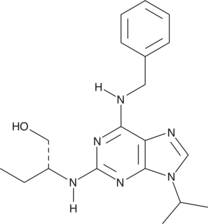Description
A phenol; active against a range of bacteria (MICs = 11-110 µg/ml) and P. falciparum strain FCB1 clone NC-1 (IC50 = 55 µM); scavenges DPPH radicals in a cell-free assay and reduces hydrogen peroxide and radiation-induced production of ROS in HaCaT keratinocytes at 2, 5, and 10 µM; inhibits the activity of EGFR, GST, prolyl endopeptidase, and glyoxalase I (IC50s = 27.5, 8, 16, and 50 µM, respectively), as well as COMT (Ki = 0.074 µM), in cell-free assays
Formal name: 2,3,4,6-tetrahydroxy-5H-benzocyclohepten-5-one
Synonyms: NCI 35676|NSC 35676|NSC 646653
Molecular weight: 220.2
CAS: 569-77-7
Purity: ≥95%
Formulation: A crystalline solid



